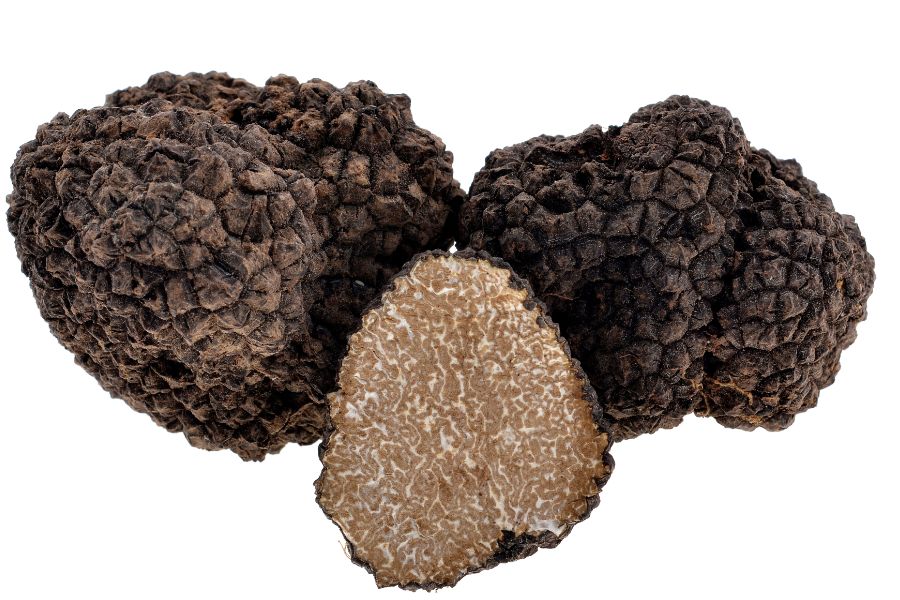Hunting for wild truffles in Nevada is nothing like picking mushrooms off a log. These underground fungi are rare, valuable, and surprisingly well hidden, even in forests you’ve walked through a dozen times.
Truffles form deep underground, growing in partnership with the roots of specific trees. That connection makes them nearly impossible to spot without some understanding of what signs to look for and where conditions line up just right.
It takes time and a lot of searching to find your first one. You might go home empty-handed more than once, but the moment you uncover even a small truffle, the effort starts to feel worthwhile.
This kind of foraging requires a different mindset that involves more focus, more patience, and a better sense of terrain. But if you know what to look for, there’s a real chance you’ll walk out with something rare, and maybe a few other surprises too.
What We Cover In This Article:
- What Wild Truffles Look Like
- Truffle Lookalikes To Avoid
- Best Practices For Finding Truffles
- Where You Can Find Truffles Around The State
- Other Great Locations For Truffles
- When The Best Time Of The Year Is To Find Truffles
- The extensive local experience and understanding of our team
- Input from multiple local foragers and foraging groups
- The accessibility of the various locations
- Safety and potential hazards when collecting
- Private and public locations
- A desire to include locations for both experienced foragers and those who are just starting out
Using these weights we think we’ve put together the best list out there for just about any forager to be successful!
A Quick Reminder
Before we get into the specifics about where and how to find these plants and mushrooms, we want to be clear that before ingesting any wild plant or mushroom, it should be identified with 100% certainty as edible by someone qualified and experienced in mushroom and plant identification, such as a professional mycologist or an expert forager. Misidentification can lead to serious illness or death.
All plants and mushrooms have the potential to cause severe adverse reactions in certain individuals, even death. If you are consuming wild foragables, it is crucial to cook them thoroughly and properly and only eat a small portion to test for personal tolerance. Some people may have allergies or sensitivities to specific mushrooms and plants, even if they are considered safe for others.
The information provided in this article is for general informational and educational purposes only. Foraging involves inherent risks.
What Wild Truffles Look Like
The U.S. is home to several native truffle species that grow wild in forests across the country. Each one has its own unique scent, appearance, and preferred habitat. Here are the types of truffles you can find:
Oregon Black Truffles (Leucangium carthusianum)
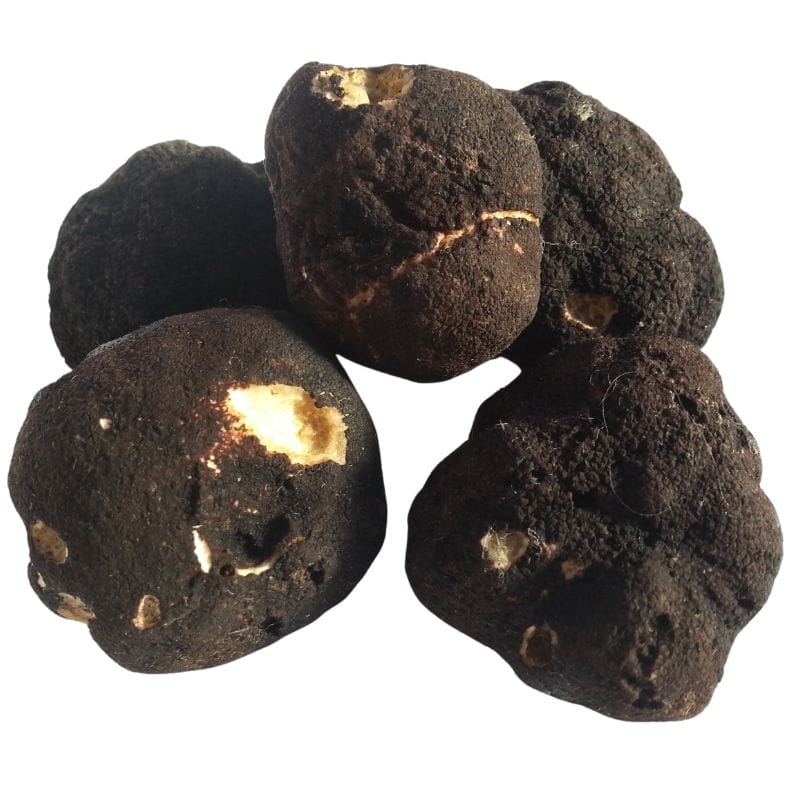
Leucangium carthusianum, also called the Oregon black truffle, grows in the Pacific Northwest and usually shows up around Douglas-fir trees. It’s a native species and one of the more well-known edible truffles from the region.
On the outside, it looks like a small lump of coal—dark black, kind of lumpy or warty, and sometimes slightly smoother in spots. They’re usually about the size of a golf ball, but they can be smaller or larger depending on the season.
Inside, the truffle is firm with a marbled pattern of gray and white veins running through it. When it’s fresh, it smells fruity, almost like pineapple, but the scent gets stronger and muskier as it ripens.
If you’re out looking for them, check in moist, shady forests with soft, loamy soil, especially where there’s a lot of moss or ferns. They grow just below the surface, so people often use trained dogs to help sniff out the ripe ones.
Compared to the Oregon white truffle, which is lighter in color and has a sharper, garlicky aroma, the black truffle has a deeper, more earthy smell. It’s also bigger and firmer than the southern U.S. truffles like Tuber lyonii, which tend to be smaller, paler, and grow around hardwoods like oaks and hickories.
Oregon Winter White Truffles (Tuber oregonense and Tuber gibbosum)
Oregon has two native white truffles that are starting to get more attention: the Oregon Winter White Truffle (Tuber oregonense) and the Oregon Spring White Truffle (Tuber gibbosum). They grow underground in forests and are prized for their strong, savory aroma.
From the outside, these truffles are small, roundish, and kind of bumpy, usually pale beige to light brown. Cut one open, and you’ll see a white interior that darkens with age, showing off a web of white veins when it’s fully mature.
The Winter White Truffle pops up from late fall into February, while the Spring White starts showing up around January and can last into June. They’re pretty similar, but the Winter variety is known for having a more powerful scent and flavor.
To find them, you’ll want to look in forests with younger Douglas-fir trees on the west side of the Cascades. Truffle hunters often check for loose soil or spots where animals have been scratching, which can be a sign there’s something below.
When fully ripe, both types give off a bold smell that’s often compared to garlic, cheese, or earthy spices. They’re usually served raw, shaved over dishes to add that truffle kick without losing any of the aroma.
Appalachian Truffle (Tuber canaliculatum)
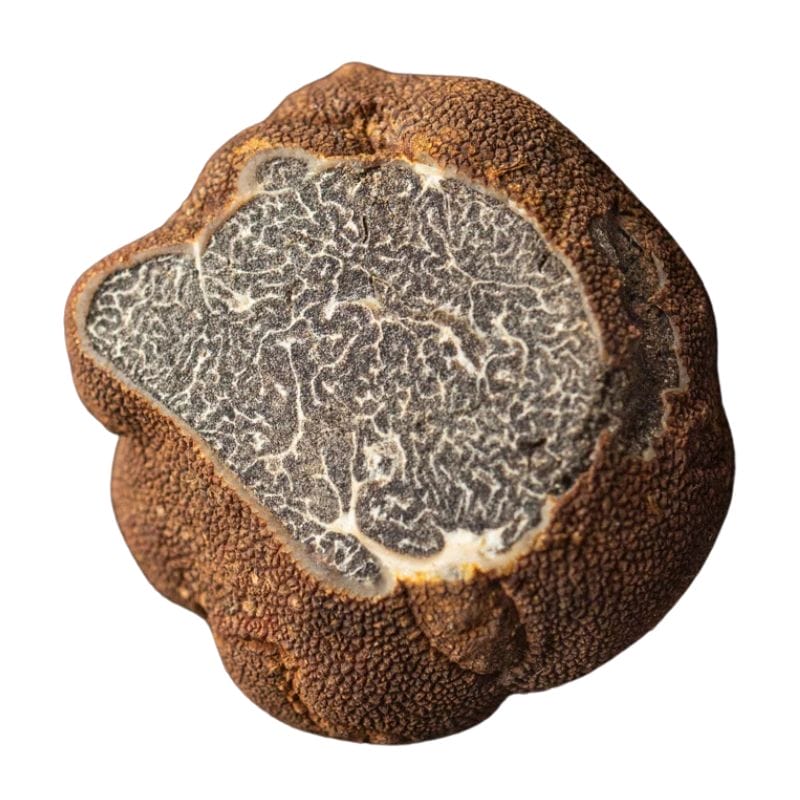
The Appalachian truffle, also known as Tuber canaliculatum, is a native North American truffle that’s slowly getting noticed. It’s about the size of a walnut and has a reddish-brown, bumpy outer surface that looks kind of like a rough, warty potato.
When you cut it open, the inside is firm and dark brown with thin white veins running through it like a marbled pattern. If it’s fully ripe, the smell is strong and earthy—some say it has a kind of nutty, funky aroma that stands out.
You can find these truffles in mixed hardwood forests, especially around oaks and pines, from late summer through fall. They grow underground, so look for spots where the soil is loose and animals like squirrels have been digging—sometimes that’s a good clue.
If you’re foraging, gently raking the top layer of soil near tree roots can help, but a trained dog or even a good nose makes it way easier. Once you know what to look for, the reddish color and bumpy skin are good signs you’ve found the right thing.
Compared to truffles like Tuber oregonense or Leucangium carthusianum, Tuber canaliculatum is more subtle in every way. Its smaller size and lighter scent mean you have to pay closer attention when foraging.
It’s also not as popular in the culinary world because it doesn’t pack the same punch in terms of flavor or aroma. Still, finding one can be rewarding, especially if you’re exploring different types of fungi in the area.
Desert Truffle (Terfezia and Tirmania spp.)
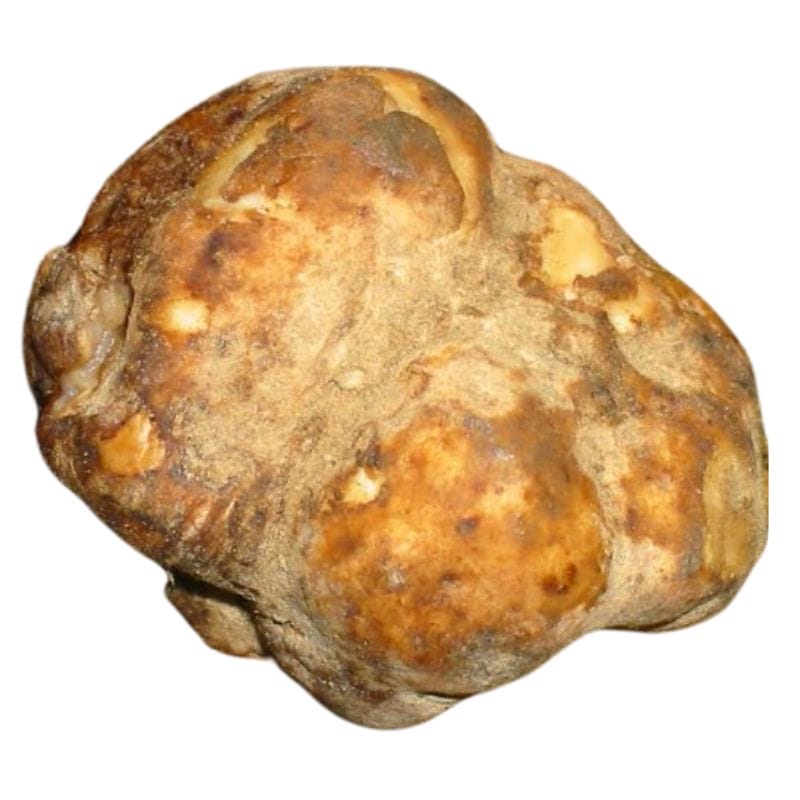
Terfezia and Tirmania are two types of truffles that are sometimes called desert truffles. These are a bit different from the truffles we usually think of, with their bold flavors and rich aromas.
These ones are a little more understated, but they’re fascinating in their own right. What makes them stand out is their ability to thrive in dry, harsh environments where you wouldn’t expect something so delicate to grow.
Unlike the earthy, intense aroma of black or white truffles, Terfezia and Tirmania truffles have a milder scent and flavor. They’re often described as nutty, with a hint of sweetness, but they lack the strong garlicky or musky notes you might associate with other truffles.
Their texture is also different—more firm and less oily than what you’d find with species like Tuber oregonense. They might not have the same culinary punch, but they’re still prized in traditional dishes, where their subtle flavors shine in simpler recipes.
When it comes to appearance, they’re easy to spot once you know what you’re looking for. They’re round to slightly irregular in shape, and their color can range from light beige to a reddish-brown, depending on the species.
The surface is usually smooth or slightly textured, without the rough, knobby look of a black truffle. Cut one open, and you’ll see a pale interior that’s often uniform in color, lacking the intricate veining you’d see in something like Leucangium carthusianum.
Pecan Truffle (Tuber lyonii)
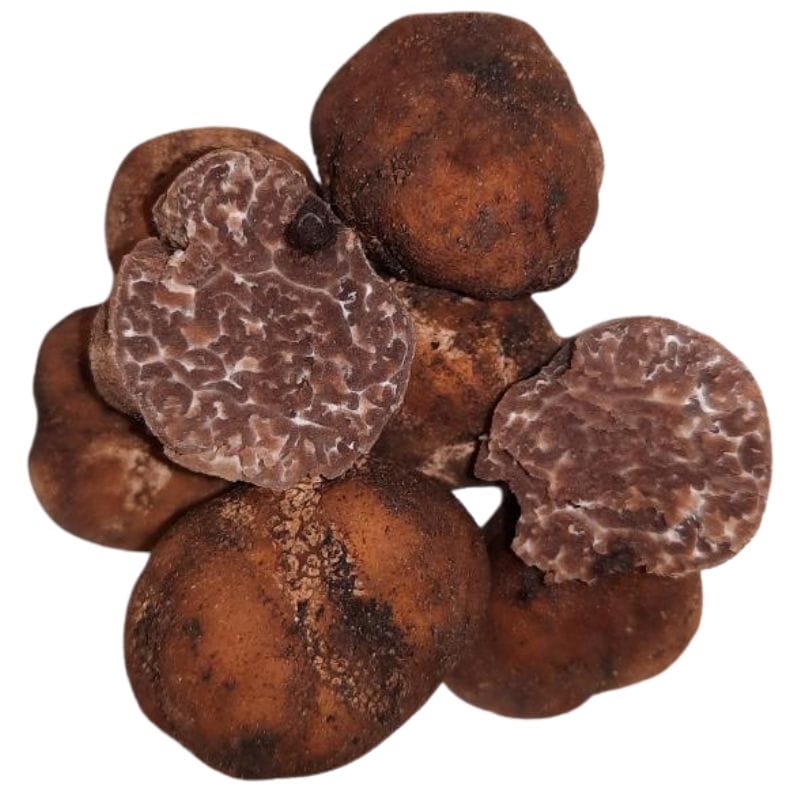
Tuber lyonii, also known as the pecan truffle, is a native North American truffle that grows underground near the roots of pecan trees. You’ll mostly find it in the southeastern U.S., especially in states like Texas, Georgia, and Mississippi.
On the outside, pecan truffles are round to lumpy and have a smooth, light brown skin that darkens as they age. They’re usually about the size of a marble or golf ball, and sometimes they even poke up slightly through the soil surface.
If you slice one open, the inside has a pretty marbled look—light tan streaks mixed with darker brown, almost like wood grain. The smell is earthy, nutty, and kind of warm, especially when they’re fully mature.
When you’re out looking for them, check under mature pecan trees or other hardwoods like oaks and hickories. Trained dogs can help sniff them out, but people sometimes spot them by looking for little cracks in the soil or raised areas near the tree’s base.
Compared to other U.S. truffles like the Oregon white truffle or the Appalachian black truffle, pecan truffles have a milder flavor and are more common in orchards. They’re a solid option in the kitchen—freshly sliced over pasta or mixed into butter—and they don’t come with the high price tag of their European cousins.
Truffle Lookalikes To Avoid
When you’re out hunting you also need to know about a few different fungi species that look very similar to the delicious truffles we’re after but are either inedible or not worth eating. Keep an eye out for:
Pine Truffles (Geopora cooperi)

Geopora cooperi is a fungus that can easily confuse someone new to truffle hunting. It’s sometimes called the pine truffle because it grows underground like a true truffle and often pops up near certain trees.
At first glance, it might seem like you’ve hit the jackpot, but this one is a false truffle, not something you’d want to eat or sell.
The easiest way to tell Geopora cooperi apart from real truffles is by looking closely at its structure. While true truffles have a smooth or slightly knobby exterior and a marbled interior, Geopora cooperi has a rougher, more irregular outer surface.
When it matures, it sometimes splits open, revealing a cup-like shape, which true truffles never do. Inside, it’s less dense and doesn’t have the intricate veining that makes real truffles so unique.
Another big difference is the smell. True truffles have a strong, rich aroma that’s earthy, sweet, or garlicky, depending on the species. Geopora cooperi, on the other hand, has a much weaker scent, and it’s not as pleasant or distinctive.
If you’re relying on aroma to identify your find, this one will give itself away pretty quickly. So, while it might look similar at first, a closer inspection will show it’s not the culinary treasure you’re hoping for.
Stinking Slime Truffle (Melanogaster ambiguus)
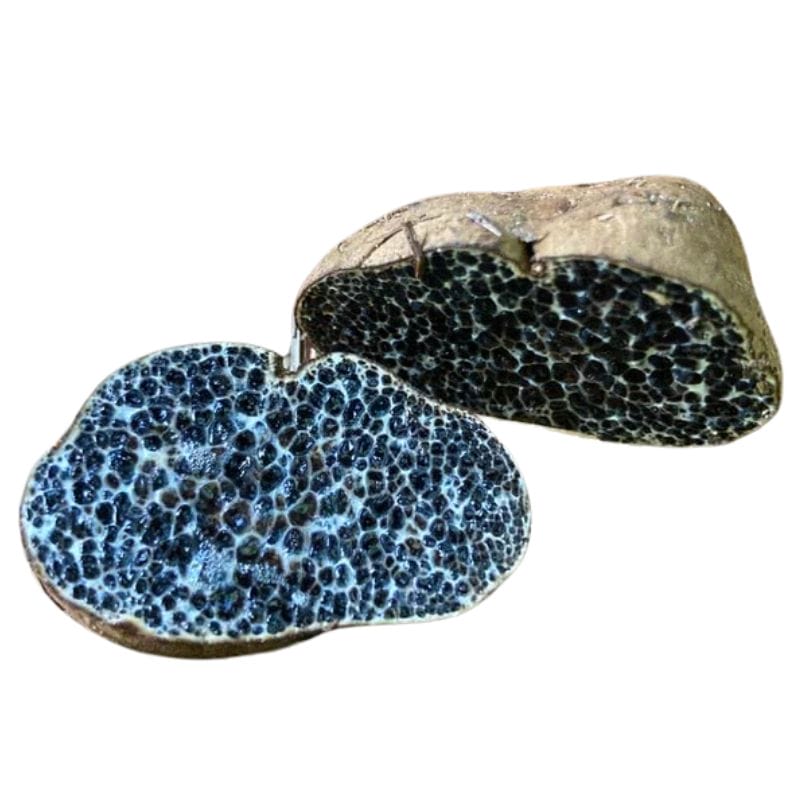
Melanogaster Ambiguus, because of their reddish-brown to dark brown exterior, might look like true truffles at first glance, but they’re quite different when you know what to look for.
The key difference is on the inside. When you cut open Melanogaster ambiguus, the interior is filled with flattened cells that have a shiny black gelatinous feel to them. Real truffles, on the other hand, have those beautiful marbled veins running through their flesh, almost like a web.
Another giveaway is the smell. While real truffles have a rich, earthy aroma that’s mouthwatering, Melanogaster ambiguus tends to have a much stronger, almost unpleasant odor—it’s not something you’d want to sprinkle on your pasta.
Earthballs (Scleroderma)
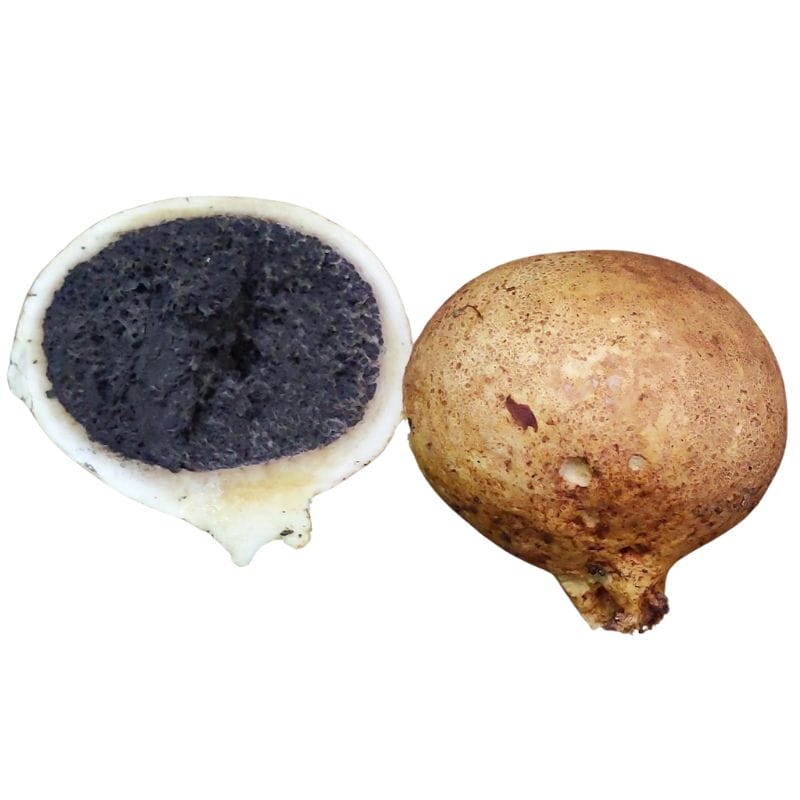
Scleroderma, commonly called earthballs, can easily fool someone who’s just starting out because they grow underground and have a round shape similar to truffles. But don’t be tricked—Scleroderma is not a true truffle, and it’s actually toxic, so it’s important to know how to tell the difference.
The first thing you’ll notice is the outer skin, which is thicker and tougher than that of most truffles. It can range in color from yellowish to dark brown, often with a rough or cracked texture.
If you cut it open, the difference becomes even clearer. While true truffles have a marbled interior with delicate white veins, Scleroderma starts out with a whitish inside that quickly darkens as it matures, turning black or purple with no marbling. It’s dense and solid, almost like charcoal in the later stages.
Another big giveaway is the smell. True truffles have a rich, earthy aroma that makes them so prized, while Scleroderma has little to no pleasant scent—some even describe it as musty or unpleasant.
Deer Truffles (Elaphomyces)
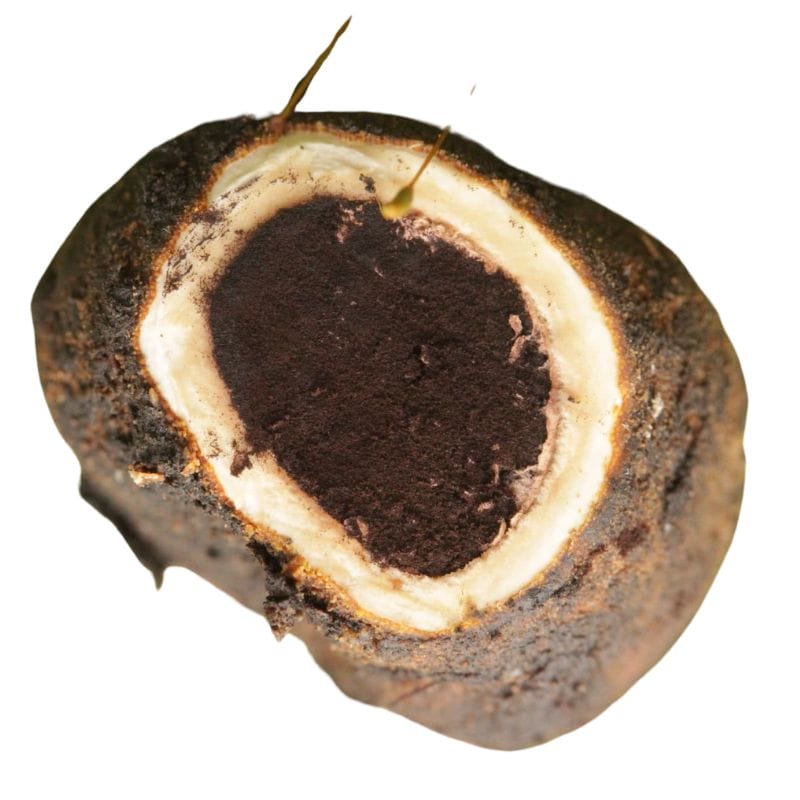
Elaphomyces, also known as deer truffles, look like true truffles at first glance, but they’re a whole different story. They’re called deer truffles because wildlife, especially deer and rodents, love to eat them. For us humans, though, they’re not edible—and definitely not what you want to mistake for a prized truffle.
Here’s how you can tell Elaphomyces apart from the real thing. First, they have a tough, warty outer surface that can range from pale tan to black, depending on the species and their age.
When you cut them open, the inside is solid and sometimes speckled or marbled, but not in the delicate, vein-like pattern you’d see in true truffles.
Their smell is also a big giveaway. Instead of the rich, earthy aroma of an edible truffle, Elaphomyces either has little scent or an odor that’s earthy but not particularly appealing.
Another thing to know is that Elaphomyces often grows deeper in the soil than true truffles, and they tend to have a harder, woodier texture.
Best Practices For Finding Truffles
Truffle hunting can be a rewarding adventure if you know the right tips and tricks. Here’s what you should keep in mind to improve your chances of finding these underground treasures:
Wait 10 to 14 Days After Heavy Rain
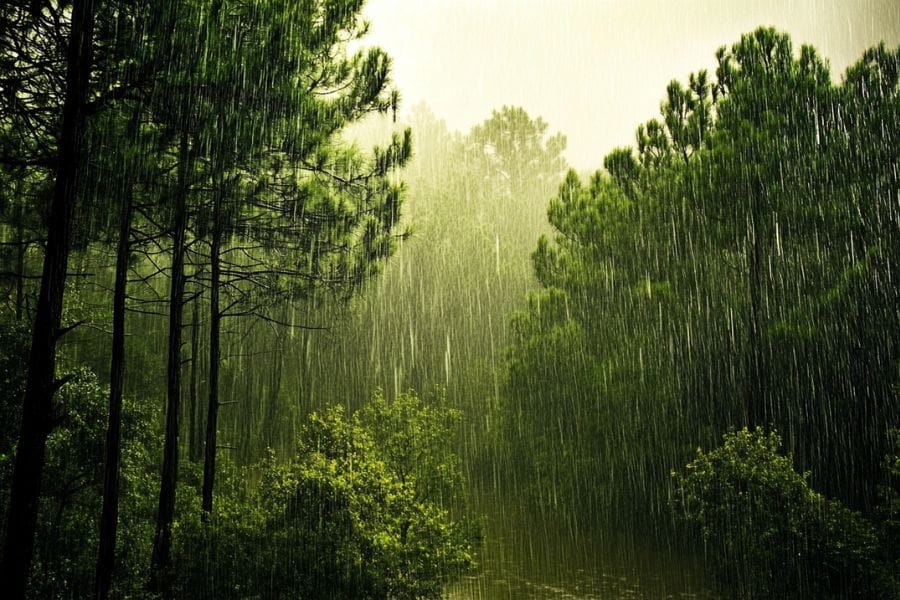
After a heavy rain, it’s best to wait about 10 to 14 days before heading out. This gives the truffles time to mature and release their signature aroma, making it easier for you (and your dog) to sniff them out. Rain helps truffles grow, but they don’t start giving off their scent right away.
As the soil warms up, the truffles get more aromatic, and the ground becomes looser, which makes digging easier without disturbing the environment too much. The timing is perfect to find truffles at their best—both in quality and in how easy they are to locate.
Find the Right Trees
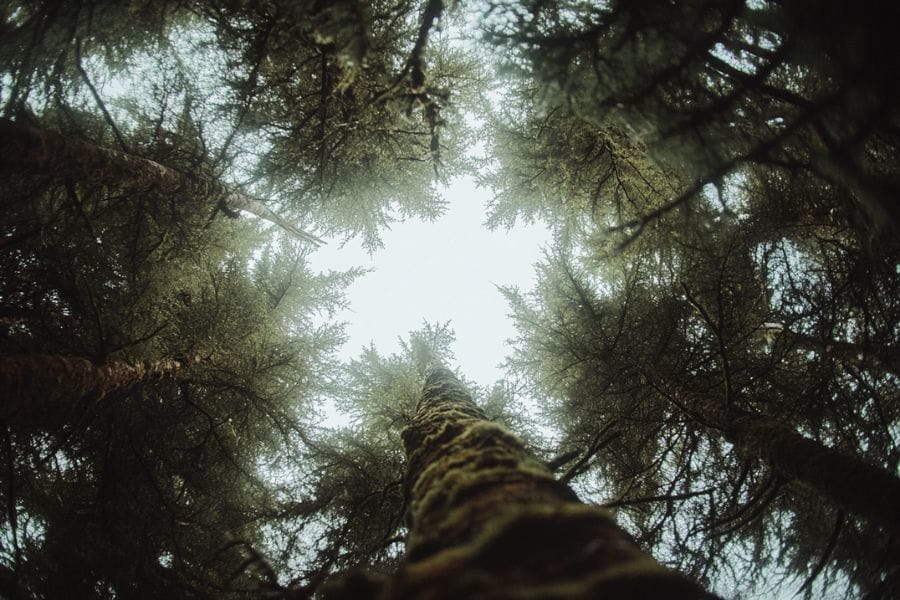
Truffles don’t grow just anywhere—they have a special relationship with certain trees. You won’t find them under just any tree, so knowing which ones to look for can make all the difference. Some of the best trees to look out for are:
- Pines
- Douglas-firs
- Oaks
- Hazelnuts
- Cypresses
- Willows
For example, if you’re looking for Oregon white truffles, keep an eye out for Douglas-fir trees. California black truffles, on the other hand, are often found near oaks and hazelnuts. The soil around these trees also needs to be slightly alkaline, so it helps to know what kind of ground you’re walking on as well.
Watch for Wildlife Activity
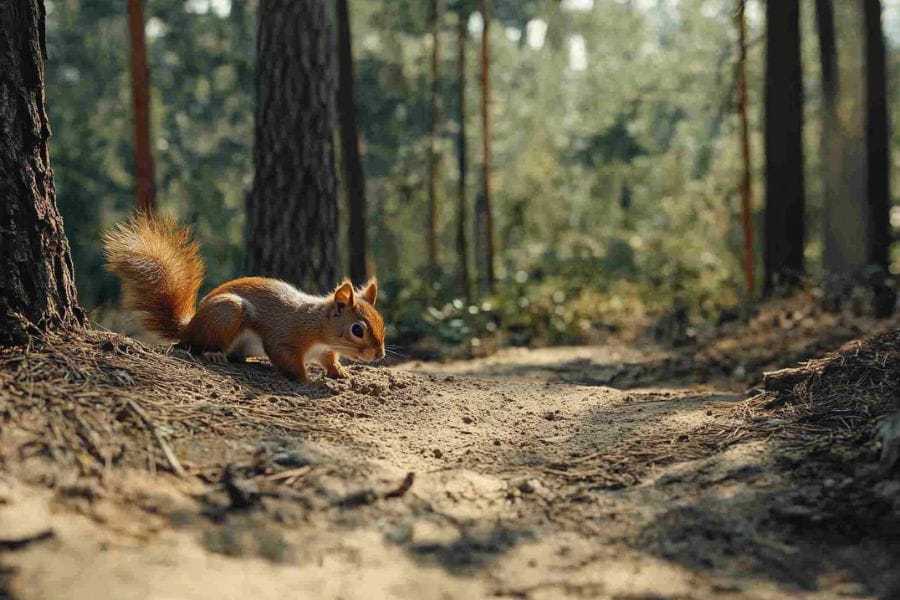
Animals like squirrels and chipmunks often help spread truffle spores, and sometimes their digging can lead you straight to truffles. While you won’t always find truffles in every pit animals dig (they also look for things like acorns or bulbs), fresh digs are a good clue. The more recent the pit, the better chance it has of leading to truffles.
Even though animals are a part of the truffle cycle, most hunters prefer using dogs to find the real treasure underground. Dogs have an incredible nose for truffles and can pinpoint their location much more reliably than any squirrel or chipmunk.
Get a Little Help from a Truffle-Hunting Dog
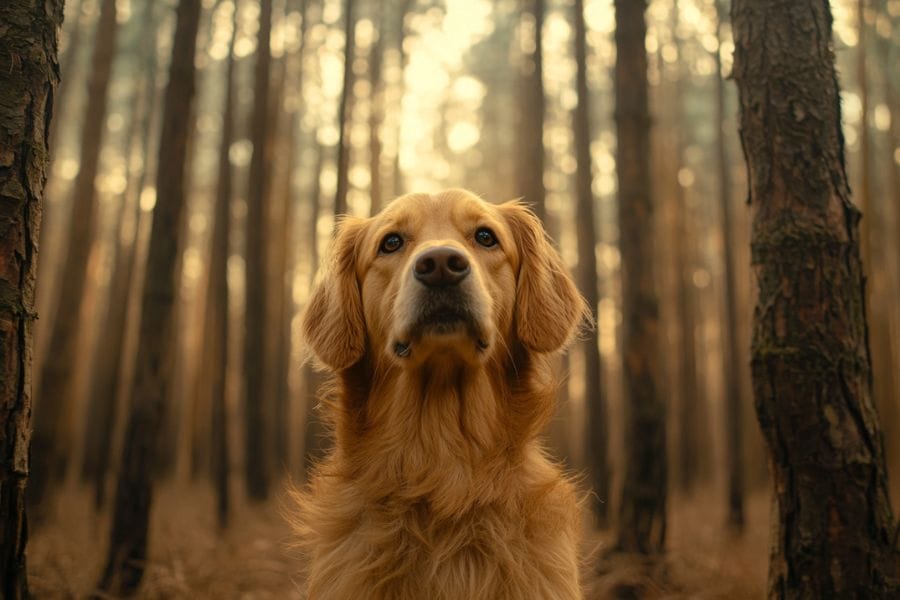
If you’re serious about truffle hunting, a trained dog can make your life a whole lot easier. Their sense of smell is extraordinary, and they’re trained to find mature truffles buried beneath the surface. Many truffle hunters swear by their dogs, and for good reason—they’re much more accurate than humans when it comes to sniffing out truffles.
If you don’t already have a trained dog, you can connect with local foraging groups or specialized trainers who offer truffle-hunting services. Some places even host events where you can see experienced handlers with their dogs in action. And if you’re feeling adventurous, you can train your own dog using truffle-scent kits and practice in a controlled space before hitting the woods.
Before you head out
Before embarking on any foraging activities, it is essential to understand and follow local laws and guidelines. Always confirm that you have permission to access any land and obtain permission from landowners if you are foraging on private property. Trespassing or foraging without permission is illegal and disrespectful.
For public lands, familiarize yourself with the foraging regulations, as some areas may restrict or prohibit the collection of mushrooms or other wild foods. These regulations and laws are frequently changing so always verify them before heading out to hunt. What we have listed below may be out of date and inaccurate as a result.
Where You Can Find Truffles Around The State
Now we’re going to go over five of the best locations for finding truffles. We’ll go a bit in-depth here and then provide a much longer list of other spots to try.
Humboldt-Toiyabe National Forest

Humboldt-Toiyabe National Forest is the largest national forest in Nevada, covering over 6 million acres. It stretches across several mountain ranges with diverse ecosystems. The forest has many pine and oak trees that truffles love to grow near.
Look for truffles in the higher elevation areas around the Spring Mountains and Ruby Mountains. These spots have the moist soil that truffles need. Check places where pine needles have built up on the forest floor.
Stream beds and creek areas are often missed by visitors but great for finding truffles. The soil is richer here. Truffles sometimes grow near the roots of older trees.
Bring a small rake to gently move the top layer of soil when hunting. Truffles usualy grow about 1 to 4 inches below the surface. The northern parts of the forest might have more undiscovered truffle patches.
Great Basin National Park

Great Basin National Park sits near the Utah border and features ancient bristlecone pine forests. The park has different elevations that create various microclimates where truffles grow. Many visitors come for the caves but miss the truffles hiding under the soil.
Wheeler Peak area is great for truffle hunting. Look where aspen groves meet pine forests. These spots have ideal conditions for truffle growth.
Lehman Creek Trail has good truffle spots with the right soil conditions. The creek gives moisture while trees provide shade. Check around fallen logs and decaying tree matter.
Baker Creek is often overlooked by truffle hunters. This area has less foot traffic and undisturbed soil. The moisture from the creek and the right trees make it perfect for truffles.
Washoe Lake State Recreation Area

Washoe Lake State Recreation Area lies between Reno and Carson City. It has wetlands, grasslands, and wooded areas where truffles grow. Most people come here for water activities.
The eastern shoreline has the best truffle spots. Look for areas with mature cottonwood and pine trees. The soil here stays slightly damp but not too wet.
After rain, check where forest meets meadow along the area’s edges. These boundaries create good truffle conditions. Use small garden tools to carefully check the soil near tree roots.
The northwest corner has quiet spots with minimal foot traffic. These areas have the right mix of sun, trees, and water access. Different truffle types grow here that you might not find elsewhere in Nevada.
Ruby Mountains Wilderness

The Ruby Mountains Wilderness gets more rain than most parts of Nevada. The extra moisture helps truffles grow well here. This mountain range has beautiful forests and meadows.
Lamoille Canyon is where serious truffle hunters go. Look around the bases of older pine and fir trees. These trees have big root systems that support truffle colonies.
High elevation meadows are worth exploring after rainfall. The rich soil helps truffles develop. Gently rake the top soil layer around tree roots to find hidden truffles.
Island Lake Trail has unexplored areas with valuable truffle varieties. Check spots where sunlight filters through trees but doesn’t hit the ground directly. These places keep the cool, moist conditions that truffles like.
Mount Charleston Wilderness

Mount Charleston Wilderness rises above the Las Vegas desert. It reaches over 11,000 feet high. The mountain creates its own climate that’s perfect for truffles.
Cathedral Rock Trail has a mix of aspens and conifers that partner with truffles. Search under thick pine needle carpets in quiet areas. Truffles grow where water collects after rain or snow melts.
Kyle Canyon has unique soil with lots of organic matter. Dig gently around mature tree roots. If you see mushrooms above ground, truffles might be growing below.
The western slopes are less visited but great for truffle hunting. This mountain is special because it’s isolated from other forests. Some truffle types here might not grow anywhere else in Nevada.
Other Great Locations For Truffles
Northern Nevada
| Location | Collection Details |
|---|---|
| Austin Hills Recreation Area | Ideal for seasonal truffle foraging under BLM rules. |
| Black Rock Desert-High Rock Canyon | Truffle collection permitted in vegetated areas between dune fields and sagebrush. |
| Carson City BLM Lands | You can harvest truffles in shaded pine groves using hand tools only. |
| Carson Range National Forest | Spring and fall collections allowed along moist forest trails near trailheads. |
| Diamond Valley Wildlife Management Area | Limited foraging allowed along designated footpaths, avoid active wildlife zones. |
| Egan Canyon BLM Lands | Small-scale digging permitted near mature conifers at canyon edges. |
| Franklin Lake WMA | Truffles may be collected near cottonwoods on the southern lake margin. |
| Humboldt-Toiyabe National Forest (northern section) | Best foraging around decomposing pine logs at mid-elevations—no rakes allowed. |
| Jarbidge Wilderness Borderland | Foraging permitted outside restricted zones; steep slopes require extra caution. |
| Lamoille Canyon BLM Lands | Popular site with shady forest floors—gather only what’s visible at surface level. |
| Mount Rose Wilderness Area | Fungi collection allowed near snowmelt streams and under fir tree clusters. |
| Osgood Mountains Wildlife Area | Low-foot-traffic area with scattered truffle patches near volcanic ridges. |
| Pine Forest Range BLM Lands | Digging permitted with soft tools near old juniper stands. |
| Ruby Mountains National Recreation Area | Look for truffles around cottonwood roots, collection permitted in dry periods. |
| Santa Rosa Range BLM Lands | Forage early morning along dew-covered moss beds. |
| Sheldon National Wildlife Refuge | Walk-in truffle gathering permitted in non-sensitive zones only. |
Central Nevada
| Location | Collection Details |
|---|---|
| Big Smoky Valley BLM Lands | You can dig near creek bends with soft soil and tree shade. |
| Carson Lake WMA | Collection allowed around lake periphery where organic debris gathers. |
| Desatoya Mountains BLM | Seasonal fungal collecting allowed under tree clusters in higher elevations. |
| Eureka Sand Hills BLM Lands | Look for signs of truffle activity around scattered pinyon pines. |
| Fernley Wildlife Management Area | Surface-level collection allowed in marshy woodlands during dry spells. |
| Fish Creek Range BLM Lands | Loose valley soil near aspen groves is ideal for hand-harvesting. |
| Gabbs Valley BLM Lands | Permitted in riparian corridors with adequate ground litter. |
| Railroad Valley BLM Lands | Digging only permitted in shaded ravines with leaf buildup. |
| Reese River Wilderness Study Area | Foraging allowed away from restoration plots—check signage at trail start. |
| Sand Mountain Recreation Area | Avoid dune crests—truffle zones are in lower tree-covered sections. |
| Shoshone Mountain BLM Lands | Seek under cedar trees along less-traveled hiking trails. |
| Simpson Park Wilderness | Truffle growth is common under decaying brush—collection allowed near ridge trails. |
| Stone Cabin Valley BLM Lands | Truffles found in moist depressions after rain—collection allowed without tools. |
| Toiyabe National Forest Range | Use hands only to gather surface truffles near moss-covered trunks. |
| Twin Mountains BLM Lands | Digging permitted during October–February beneath oak-dominated slopes. |
Southern Nevada
| Location | Collection Details |
|---|---|
| Ash Meadows National Wildlife Refuge | Only small surface truffle collection allowed near cottonwood patches. |
| Charleston Peak Wilderness Area | Allowed below 9,000 feet near tree lines—avoid protected alpine zones. |
| Desert National Wildlife Refuge | Truffles may be picked under mesquite in lower wash areas. |
| Gold Butte National Monument | Foraging permitted outside cultural heritage and tortoise zones. |
| Lake Mead National Recreation Area | Forested canyons allow fungi picking during early spring. |
| Las Vegas BLM District | Limited collection near old-growth areas west of Sloan Canyon. |
| Mount Charleston SNRA | Dig only where duff is loose—no collection near picnic or campsite areas. |
| Mormon Mountains BLM Lands | Best foraging after light rainfall near exposed roots in shaded valleys. |
| Pahranagat National Wildlife Refuge | Collect truffles near southern groves—keep clear of wetland boundaries. |
| Red Rock Canyon NCA | Allowed on select trails in pine-sage transition zones. |
| Spring Mountains National Recreation Area | Truffle collection permitted at mid-elevations between limestone outcrops. |
| Upper Las Vegas Wash Conservation Lands | Truffles found along older tree stands near the wash basin. |
| White Pine Range BLM Lands | Forage in well-shaded groves far from active livestock zones. |
| Wheeler Pass Wilderness Study Area | Late-season foraging allowed near spring-fed forest pockets. |
| Wilson Creek Range BLM Lands | Surface truffle collection allowed where brush cover is thick and unburned. |
When The Best Time Of The Year Is To Find Truffles
The best time to hunt for truffles in Nevada is from late October through early April. Fall rains kickstart the growing season, with November and December being particularly productive months.
Winter truffles are often more flavorful and mature. The Sierra Nevada foothills yield better results in the cooler months when soil moisture levels are higher.
Spring brings a second, smaller harvest window in March and early April. Summer months are too hot and dry for successful hunting.
Different elevations extend the season, with higher mountain areas producing later into spring than valley locations.
One Final Disclaimer
The information provided in this article is for general informational and educational purposes only. Foraging for wild plants and mushrooms involves inherent risks. Some wild plants and mushrooms are toxic and can be easily mistaken for edible varieties.
Before ingesting anything, it should be identified with 100% certainty as edible by someone qualified and experienced in mushroom and plant identification, such as a professional mycologist or an expert forager. Misidentification can lead to serious illness or death.
All mushrooms and plants have the potential to cause severe adverse reactions in certain individuals, even death. If you are consuming foraged items, it is crucial to cook them thoroughly and properly and only eat a small portion to test for personal tolerance. Some people may have allergies or sensitivities to specific mushrooms and plants, even if they are considered safe for others.
Foraged items should always be fully cooked with proper instructions to ensure they are safe to eat. Many wild mushrooms and plants contain toxins and compounds that can be harmful if ingested.

